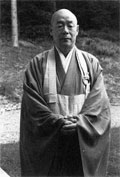POINTS OF DEPARTURE: Zen Buddhism With a Rinzai View
By Eido T. Shimano.
The Zen Studies Society Press: Livingston Manor, New York, 1991.
190 pp. $17.00 (hardcover), $12.00 (paperback).

When formal Zen practice began in earnest in this country in the sixties, the Rinzai Zen emphasis on the attainment of enlightenment-experience (kensho) served as the dominant model of practice. More recently, it would seem that Soto Zen has become the more dominant school, in part because of its deemphasis of kenshoand its emphasis on the fact of original enlightenment.
Yet, if Soto Zen’s popularity has anything to do with endorsing he growing tendency among Zen students to practice as if enlightenment-experience has nothing to do with Zen, then it’s time for a Rinzai revival.
One of the more impressive achievements of Points of Departure is the way Eido Roshi balances the traditional Rinzai Zen insistence on the importance of kensho with realistic assessments of the scope of the transformation involved. For example:
Generally speaking, we are not strong. We are rather greedy and rather lazy. We are fearful, and we have confusions and anxieties. But when we can testify to, and sense, see, and feel buddha nature itself, these inner anxieties will be allayed. The reason why our anxiety is so acute is that we don’t know what we really are. Once that is settled by realizing true Buddha nature, we can calm down. There may still be greed, jealousy, anger, and other problems resulting both from our past habits and from karma, but one essential problem is solved.
One of the reasons for the above-mentioned shift from Rinzai to Soto may be the false advertising associated with kensho—moral perfection, psychological health, etc.
The book is divided into four parts: I: The Subtleties of Buddha Nature; II: Growth; III: Commentaries on Rinzai Zen Practice; and IV: Teishos in the Rinzai Spirit. The two best talks in Part I are inspired by two marvelous haiku by Soen Roshi:
All beings are flowers,
blooming
in a blooming universe.
and:
Crawling out of the Dead Sea,
My body,
Glittering spring water.
The talk in Part II entitled “Appreciating the Fourfold Wisdom” is the best commentary I have come across on the koan called “The Woman Comes Out of Samadhi” (The Gateless Gate, Case 42). One of Eido Roshi’s distinctive talents is a powerful appreciation of what might be called “Dharma Drama”; this was unquestionably true of his teacher, Soen Roshi, and is the hallmark of the Rinzai Roku. The spirit of Rinzai, and thus of Rinzai Zen, embodies a way of teaching called “Soshi Zen”—no verbal, intellectual understanding or explanation, just dynamic presentation; the other way of teaching is called “Nyorai Zen,” which is the more verbal, intellectual understanding of Buddhadharma. Although Eido Roshi clearly wishes to advocate the essential importance of Soshi Zen, in a way, by characterizing his book as a Rinzai view, he subtly does himself a disservice; for what may be truly distinctive about his matured Zen style of teaching is that it balances—or at least aspires to balance—both Soshi and Nyorai Zen. Of these teaching styles he sagely remarks: “We cannot say which is better; we need both.”
Parts III and IV give the reader the strong, vital taste of Rinzai Zen and make this book the strong, vital text it is. I was particularly struck by Eido Roshi’s remarks on the famous koan (Blue Cliff Record, Case 11), “Don’t you know that in all the land of Tang there is no Zen teacher?” Many Zen teachers, of course, talk about this koan, but for obvious reasons might think twice about actually convincing their students that there are no teachers of Zen. What struck me as I read his remarks was simply that he really meant what he was saying. In 1976 when I left Dai Bosatsu Zendo, I vividly recall Eido Roshi’s saying to me, “There is no teacher but zazen.” Frankly, the remark did not ring true to me at the time, and now, even he might agree. In this regard in “Who Is The Teacher,” he writes:
But there is no teacher, as such, for you to rely on but yourself. Yourself. This is a unique part of the Zen tradition. In some other traditions it may be said that someone teaches something to the student…. But from the essential viewpoint, there is no giver, no receiver, no donation. The giver is shunyata, the receiver is shunyata, the donation is shunyata. Teaching is also shunyata. To realize this by your own effort is called Zen practice and Zen realization…. Now here is a subtle point. It is said that sutra reading is unimportant. But it says that in the sutras. Unless you study the sutras, you will not understand the insignificance of studying the sutras. It is this way with a Zen teacher. Unless you have studied with a teacher, you will not understand the importance of depending upon yourself. So you should do both: you should study with a teacher, and you should recognize the limited role of the teacher. You are the student, and you are the teacher.
Thank you for subscribing to Tricycle! As a nonprofit, we depend on readers like you to keep Buddhist teachings and practices widely available.